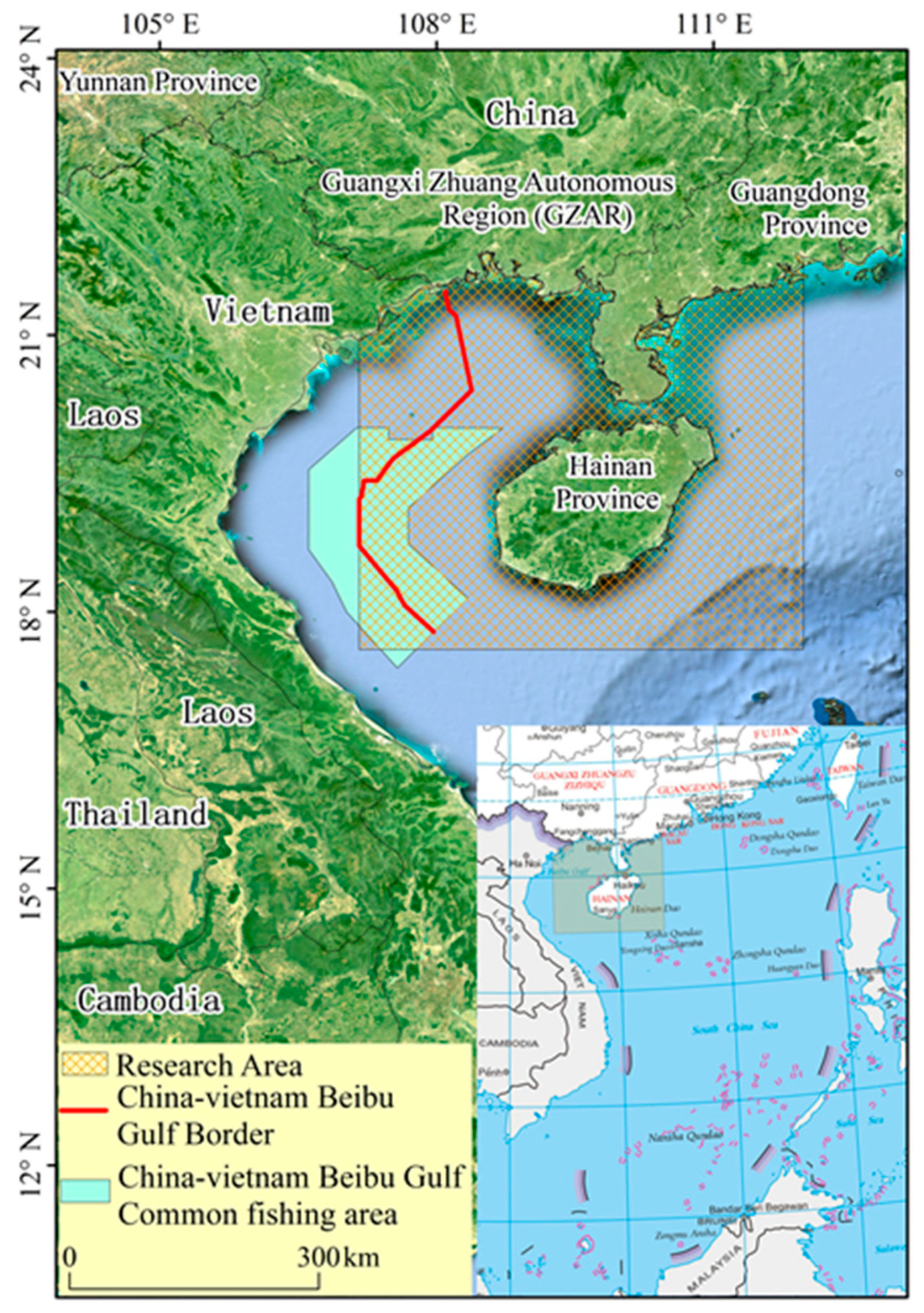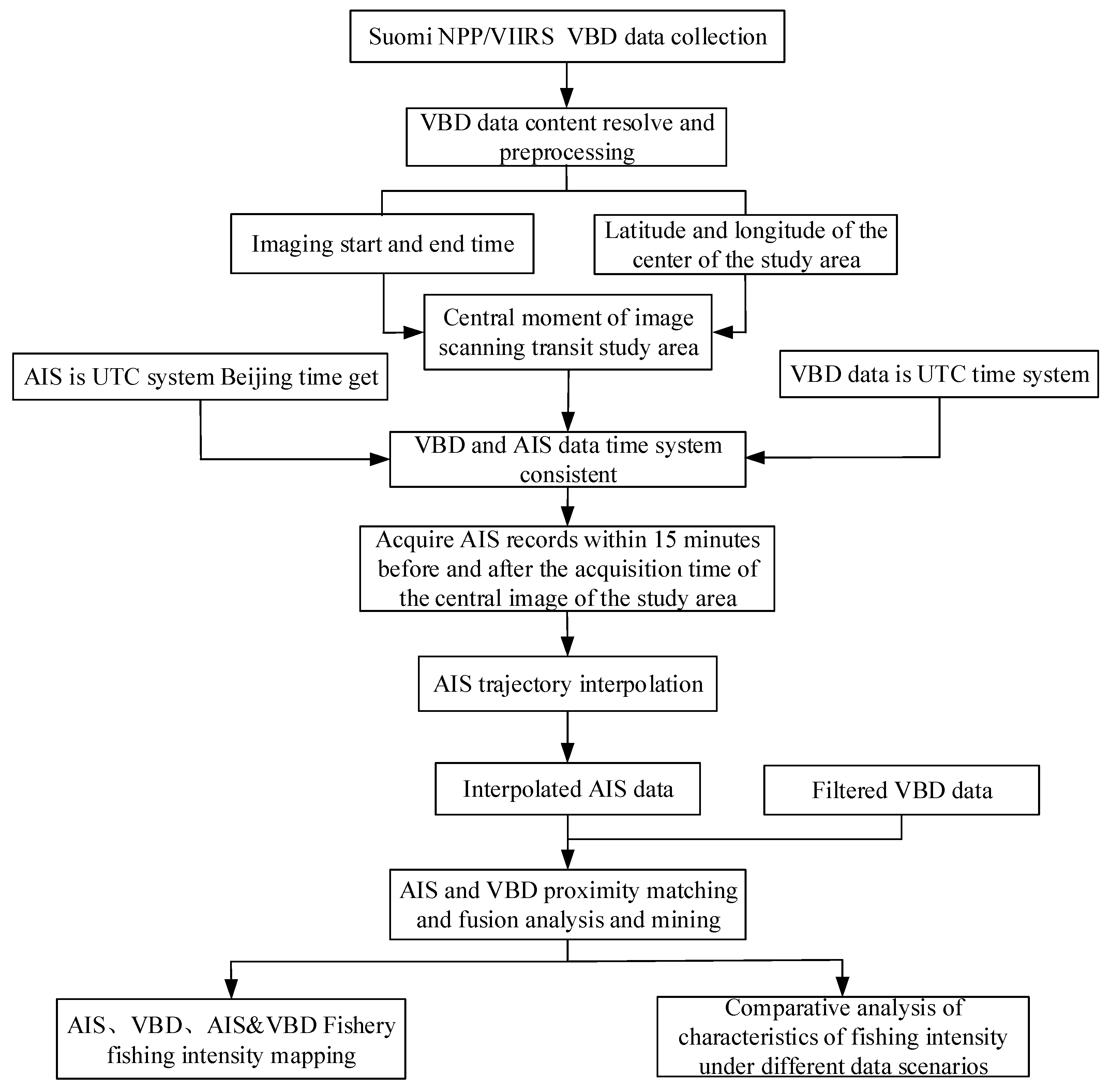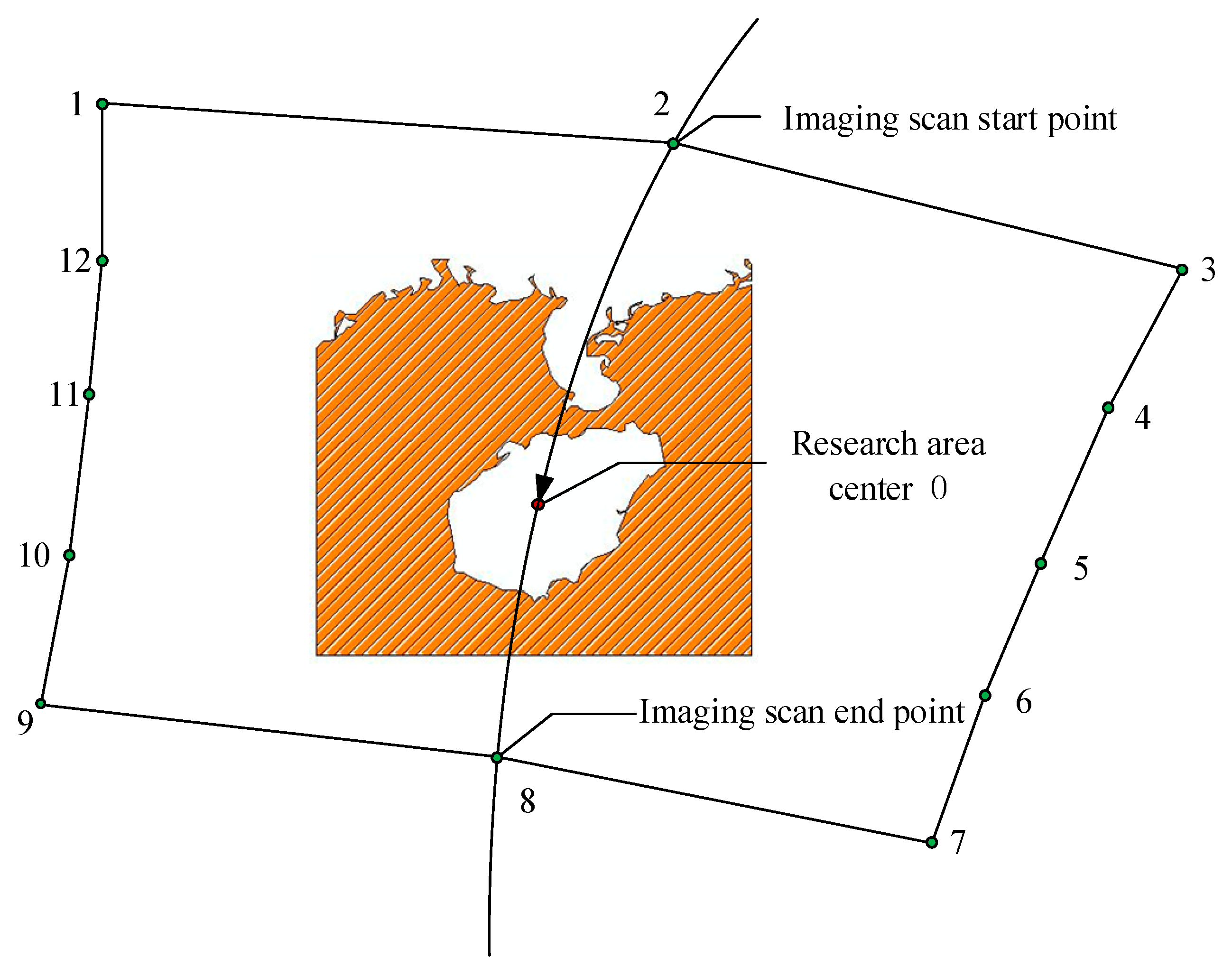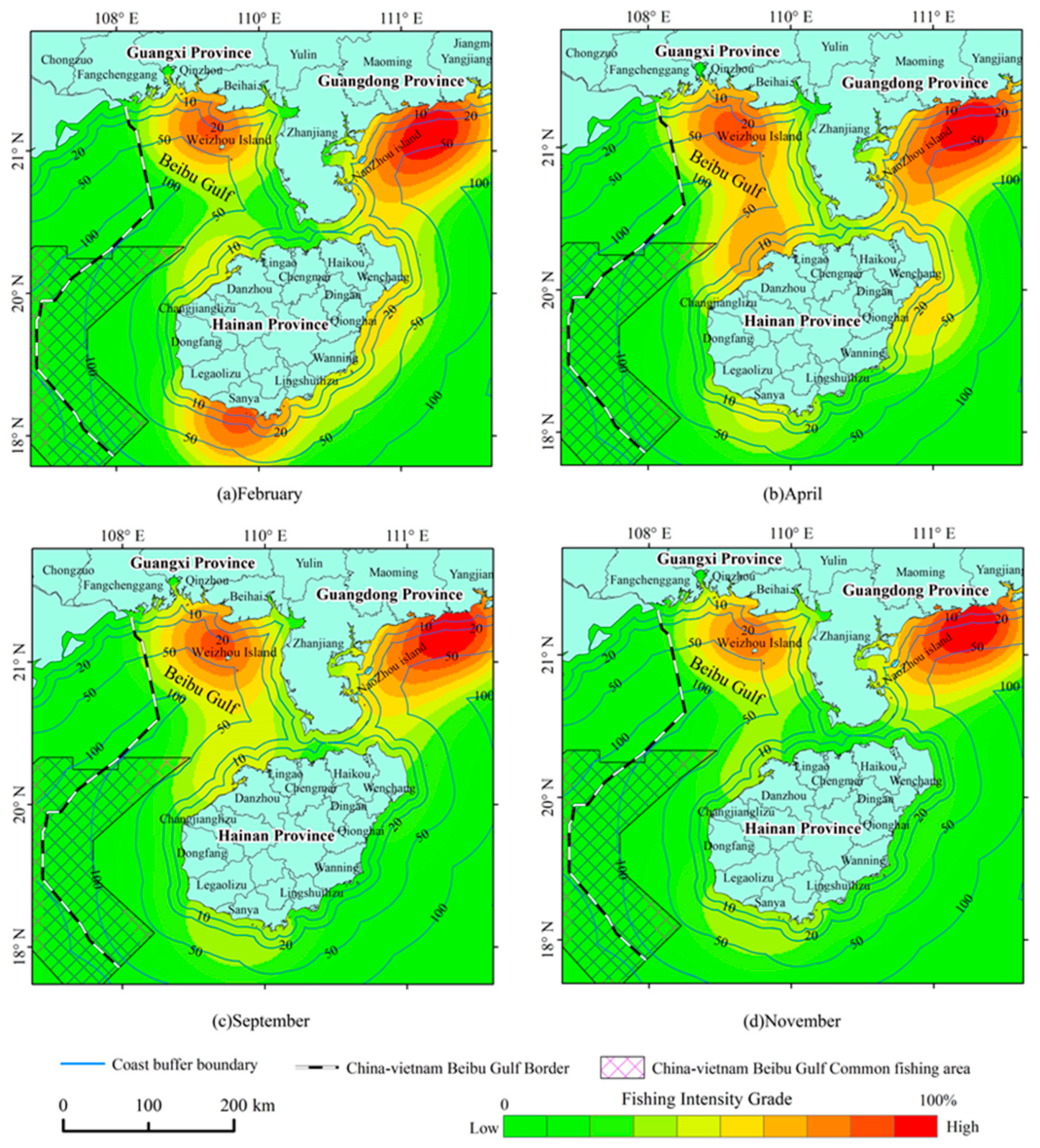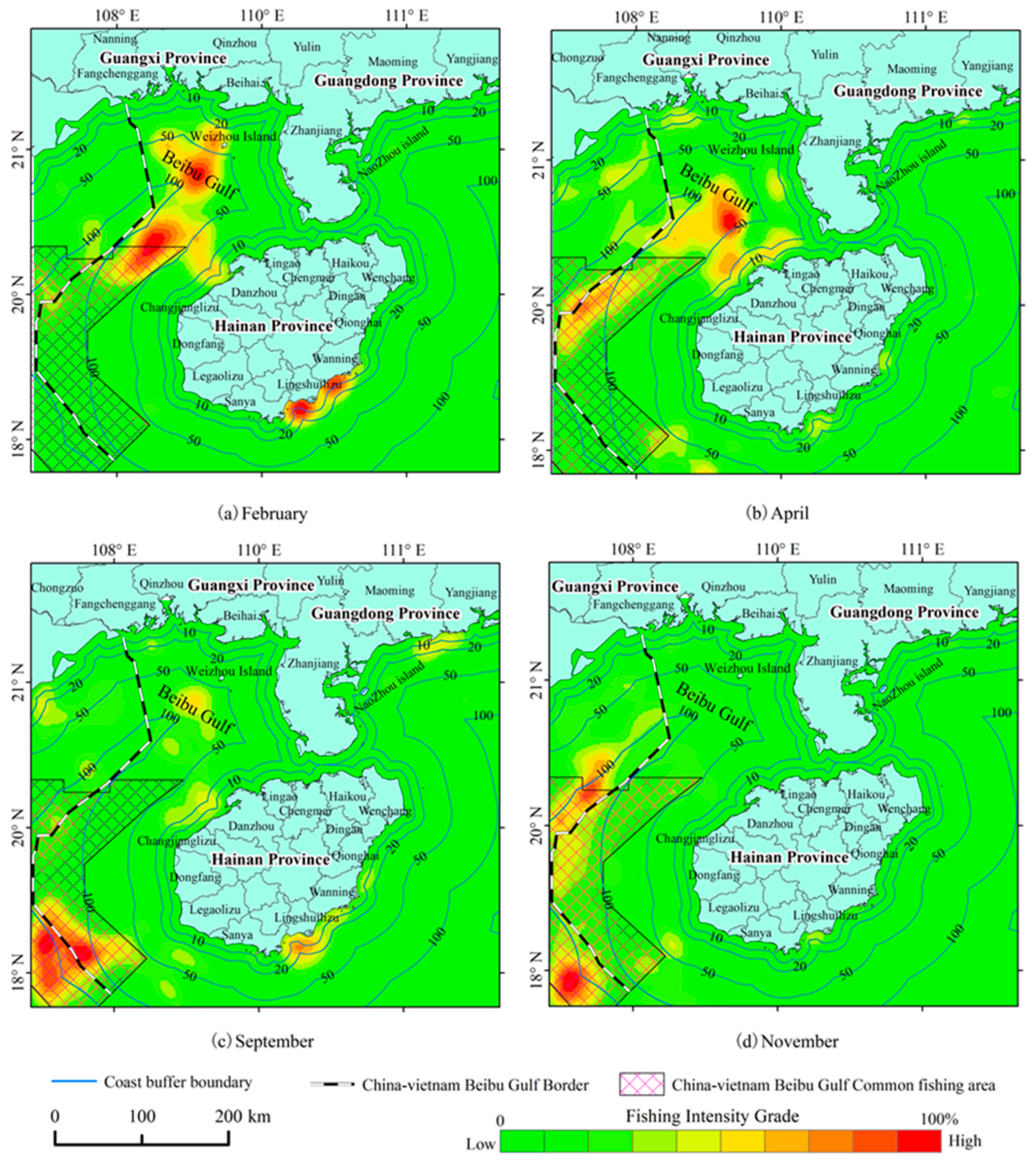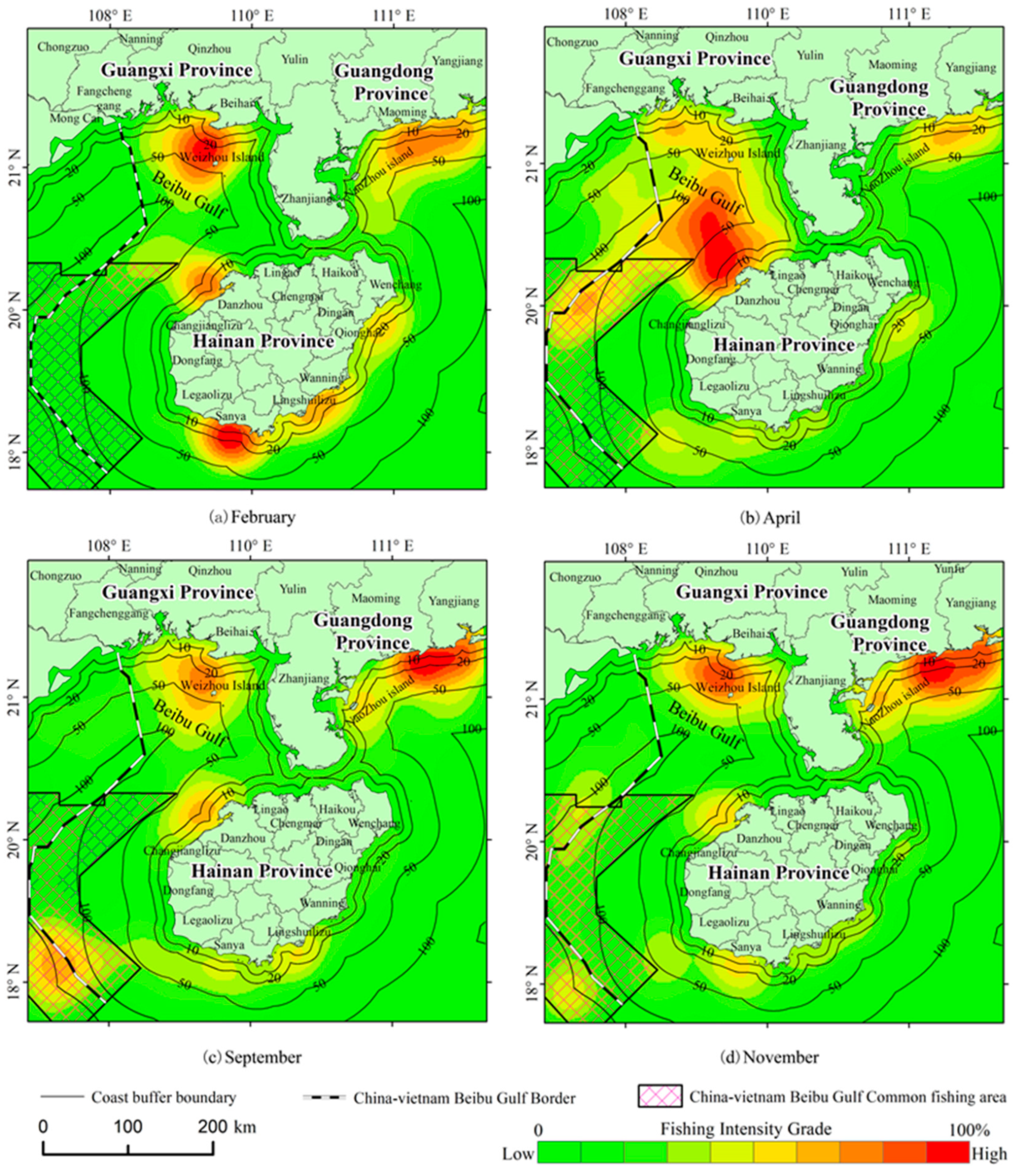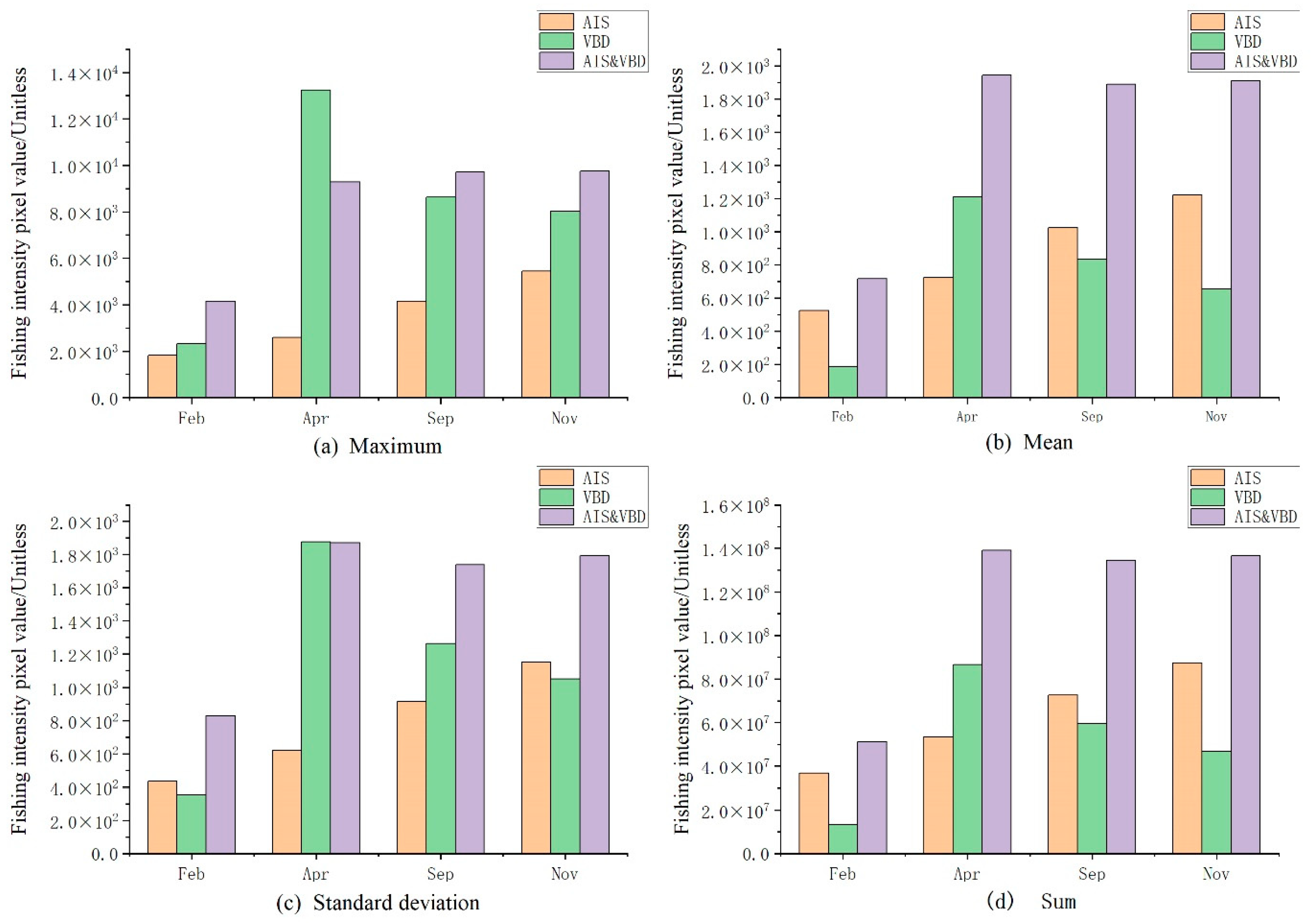1. Introduction
Marine fisheries play a vital role in food security and marine economic development [
1,
2]. However, with advances in fishing technology and an increased market demand for fisheries, the increased intensity of marine fishing, deteriorating marine ecological environments, and the increasing frequency of IUU (illegal, unreported, and unregulated) fishing incidents have presented significant challenges to the sustainable development of marine fisheries and the conservation of fish species diversity [
3,
4]. There has been a lack of effective integrated fishing assessment management practices and measures [
5]. and therefore the scientific determination of fishing intensity data in marine fisheries is pre-requisite and key to the management of fishing quotas [
6]. As an important fishing and trans-shipment carrier at sea, the quantity and spatial distribution of fishing vessels reflect the primary development trend of fishery resources. In the age of big data, the location data of fishing vessels have become an essential support for the dynamic spatial features of marine fisheries [
7,
8]. Accurate, in-depth analysis and map visualization of fishing space information is an important way to grasp the fishing intensity of fishery resources [
9,
10]. Common ship positioning data types include AIS, VMS (Vessel Monitor System), and more. Furthermore, night light remote sensing satellite data NLT (Nightime Lights), radar imagery, and so on, can monitor the fishing vessels at sea [
11], in which night light remote sensing has ultra-high sensitivity, microlight recognition capabilities, and the ability to accurately capture fishing vessel night-time operations [
12], providing good quantification of light trap fishing vessels during night operations.
AIS and VMS trajectory data have been widely used in marine fisheries. In a marine fishery fishing intensity map, based on statistical analysis and the identification of VMS data (e.g., position, direction, speed, and so on), the fishing intensity information can be obtained effectively. Natalie et al. used the hybrid Gaussian Mixture Model in Swedish waters to segment, identify, and produce the statistical distribution characteristics of the trawler AIS speed [
13]. The validation of fishing log data has shown that the accuracy of the mapping is affected by the coverage of the AIS data. Guiet et al. analyzed the temporal and spatial changes in the intensity of industrial fishing recorded under the global AIS coverage for 2015–2017 [
14]. Research on the coupling factors, trans-shipment events, and hot-spot perception of fisheries with the help of AIS data include the following: Kroodsma et al. researched the relationship between environmental change and political events [
15]; Miller et al. tracked and analyzed 694 vessels engaged in marine fisheries fishing trans-shipment and studied the global trans-shipment of marine fisheries [
16]; and Boerder analyzed global maritime catch trans-shipment hotspots for 2012–2017 [
17].
In addition to the application of AIS and VMS to marine fisheries fishing research, the target of offshore fishing vessels in NLT provides the most intuitive reflection of human night fishing at sea [
18]. Many scholars have used such data to carry out a lot of work in the areas of marine lighting fishing vessel fishing law feature mining, situational awareness of fishery resource development, assessment of the benefits of fishing bans in sea areas, and IUU fishing monitoring [
19,
20,
21,
22]. Among them, Elvidge et al., based on Suomi NPP/VIIRS data (hereafter referred to as SNPP), proposed a peak detection and fixed threshold segmentation of the sea lighting vessel identification method for the first time [
23]. This provides a classical idea and framework for the subsequent application of NLT to the study of fishery quantification and intelligence. Subsequently, Tian et al. and Chen et al. have improved the NLT lighting operation fishing vessel identification method, based on maxEnt (maximum entropy) threshold segmentation and local peak detection LSD [
12,
24]. Using the above methods, they extracted fishing vessels in the NLT for further analysis. Zhang based on SNPP DNB data, obtained light extraction results of night fishing vessels in the South China Sea. After nuclear density analysis, obtained the core fishery of the lamplight fishing vessels were obtained and dynamic changes occurred [
25]. Geronimo et al. used NLT fishing areas and fishery management areas to map and track fishing activities accurately [
26]. The core area of fishing in the Philippines was excavated using the density clustering method, where the intensity range of different seasonal patterns was analyzed. Elvidge et al. used night lighting fishing vessels SNPP to assess the effectiveness of different types of no-fishing areas in Vietnam (toxic industrial emissions, seasonality, and coastal permanent fishing bans) [
27]. Li et al. used NLT data to study the distribution pattern of fish resources in the South China Sea [
28].
In addition to the above research on Marine fishing with single AIS, VMS, and SNPP data, Liu et al. used VMS to verify that SNPP data could effectively detect the activities of fishing vessels at sea. It was pointed out that the combination of VIIRS ship data and VMS can provide a good foundation for future fishery management [
19]. Longepe et al. used VDS (Vessel Detection System), VMS, and AIS data based on high-resolution radar images to evaluate illegal fishing in Indonesia, and found that the proportion of IUU fishing vessels changed significantly before and after the fishing ban [
29]. Hsu et al. applied VMS, VBD (VIIRS Boat Detection) in Indonesia to carry out a cross-matching study of fishing types among various vessels for the identification and analysis of illegal fishing “Dark Vessels” at sea [
30]. Based on Sentinel 1, Sentinel 2, and AIS data, Kurekin et al. developed INSURE (Integrated System for Surveillance IUU) in Ghana [
31]. Ruiz et al. assessed squid fishing over seven years using AIS and NPP/VIIRS in FAO Region 41, showing a high degree of consistency between the two types of data at a spatio-temporal scale [
32]. Park et al. combined four satellite technologies (AIS, SAR, optical imagery, and SNPP DNB band) to conduct an in-depth study on illegal fishing in sensitive areas between North Korea, Japan, and Russia [
33]. Exeter et al. utilizes VIIRS boat detections (VBD) and GPS data to predict fishing effort, biomass and value, as well as the spatial and temporal distribution of catch [
34].
In conclusion, the complementary advantages of AIS/VMS, VBD, and multi-source data in existing studies, to a certain extent, have provided important support for understanding the spatial and temporal intensity and dynamic changes of fishing. However, from a more accurate and microscopic perspective, there are also some deficiencies: (1) A single AIS/VMS has the phenomenon of uneven coverage size (The further offshore, the coarser the data sampling interval) [
35]; (2) Not all ships are equipped with AIS equipment and may have low VMS coverage rate; (3) NLT can only reflect the saturated spillover effect of targets and nearshore data for high-intensity light trapping vessels; that is, the target extraction effect of vessels in nearshore areas (5 km) is not good. Moreover, it can only reflect the operation situation of the whole light trapping vessel in the sea area and cannot carry out fine-scale identification and analysis. In addition, it cannot effectively meet the management and containment of IUU in sea areas outside the prohibited fishing area and time limit; (4) Marine ship lights mainly come from fishing boats, oil and gas platforms, and so on, while the proportion of fishing boats and whether lights from other ships that can be captured by NLT are unknown. It can be concluded that the existing studies have focused more on the analysis and mining of the fishing intensity characteristics of Marine fisheries by using a single data source [
13,
25]. Although there are cases in existing studies that have combined multiple sources of data, most of them have focused on illegal fishing at sea, and there are still no cases that combine the advantages of the two and explore fishing intensity information of Marine fisheries through their fusion [
29,
30,
31,
32,
34].
Based on this research status, this paper makes full use of such a strategy of combining the advantages of NLT and ship AIS data, in order to put forward a method to obtain the fishing intensity of Marine fisheries by integrating multi-source data. Taking the northern waters of the South China Sea as the research area, the typical season of 2018 was selected to conduct experiments using the proposed method. It is expected to provide an avenue for the information management of fishery resources, assessment of fishing intensity, protection of the legitimate rights and interests of fishing vessels, and to provide information sources and references for the formulation of scientific and effective fishery management and protection policies.
4. Analysis of Experimental Results
4.1. AIS and VBD Match Analysis
Taking AIS as the benchmark data and VBD as the data to be matched, 219,847 (interpolated AIS) AIS records and 61,855 VBD records in the study area were selected for proximity matching analysis. About 4164 were matched to the target, accounting for about 1.89% of the AIS benchmark data and 6.73% of the VBD data to be matched. Further analysis of the matched VBD successfully combined with AIS attribute information showed that fishing boats accounted for 49.42% of VBD obtained by neighbor matching, while cargo ships, tankers, tugboats, passenger ships, and other vessels accounted for 20.89%, 6.54%, 1.83%, 1.49%, and 19.9%, respectively. According to the matching information, it can be concluded that most of the matched VBD data obtained from maritime detection were from fishing boats that performed light trapping at night. However, the lights generated by other ships at sea can also be picked up by noctilucent remote sensing satellites, as they pass through the sea. This also fully demonstrates that it is very effective to use light to obtain fishery information, in order to analyze dynamic fishery change and spatiotemporal variation characteristics of fishery grounds. Furthermore, no matter whether the input AIS benchmark data or the input VBD data were to be matched as the measurement index, it can be seen that the successful matching ratio of the two types of data was relatively low. In other words, the integration of the two types of data could more effectively mine and analyze the fishing situation. In addition, about 23.68% of the MMSI of the ships that were matched were incorrect. According to the analysis of vessels without abnormal MMSI, ships of Chinese nationality accounted for 77.49%. Among ships from other countries, the top three were Panama, the Marshall Islands, and Vietnam, accounting for 4.74%, 2.71%, and 2.61%, respectively.
4.2. Analysis of Fishing Intensity Characteristics
4.2.1. Based on AIS Fishing Intensity Analysis
In order to better identify the advantages and disadvantages of the various data used in Marine fishery analysis, as well as the differences before and after fusion, based on the perspectives of AIS, VBD, and their fusion, we conducted a comparative analysis of the respective fishing intensity data obtained. Based on the time in the satellite transit study area, the AIS data obtained by screening, integration, and sampling were used to form a fishing intensity map of the Marine fishery. The processed AIS data can avoid the problem of inconsistent granularity of data time interval, caused by the distance of fishing boats offshore. It can be seen, from
Figure 5, that AIS better reflected the fishing intensity of the nearshore fishery. The results indicated that: (1) The fishing intensity near the coastal areas of Guangdong and Guangxi Provinces was always higher than that around Hainan Island. The change of fishing intensity was small on the macroscopic scale, especially in the coastal areas near Guangdong and Guangxi Provinces; however, there were slight changes at the detailed scale, such as in the waters around Sanya and Danzhou in Hainan Province. (2) The fishing intensity in the coastal areas of Guangdong Province was always higher than that around Hainan Island, and the fishing intensity in the coastal areas of Guangdong Province was always the highest within the selected time range. (3) The offshore distance of the high-intensity fishing distribution area, based on AIS data, was about 20–50 km. Therefore, the fishing intensity map produced by the AIS data of fishing vessels obtained through screening and interpretation sampling has good applicability within the sea area of 50–70 km offshore. However, the results are limited to countries and regions where AIS equipment is mandatory for fishing vessels.
4.2.2. Based on VBD Fishing Intensity Analysis
Compared with AIS data, the prominent advantage of VBD data is that it has reasonable objectivity in spatial distribution. Because the fishing resources in the northern part of the South China Sea are extremely rich, there is illegal fishing by fishing boats from other countries and regions. In order to avoid exposure, fishing boats will turn off the AIS equipment when operating in this area. Therefore, this section still adopts the method used in previous Marine fishery fishing research on light data to obtain fishing intensity, but the difference is that the target data of non-fishing vessels that match successfully is eliminated. It can be seen from
Figure 6 that the fishing intensity data obtained based on VBD data in the study area are different in both spatial distribution and temporal coverage. With people in the past, “nearshore fishing intensity is high, far shore fishing intensity is low” understanding is quite different. The fishing intensity reflected has the following characteristics: (1) Most of the high-intensity fishing areas are located 50 km away from the offshore, and most of the study areas are located within 50 km or nearby the China-Vietnam common fishing area. However, it is also found in coastal areas, such as Danzhou, Lingshui, and Maoming of Guangdong Province. (2) The spatial distribution of fishing intensity was significantly different from month to month. For example, the areas with high fishing intensity in February were concentrated in the range of 50–100 km offshore, such as Lingshui in Hainan and within 20 km offshore at the boundary of Lingshui and Wanning. (3) The characteristics of high-intensity fishing areas are mainly isolated “clumps”, and the adjacent high-intensity “clumps” converge to form a “strip” feature, which is more prominent in the Beibu Gulf region of China and Vietnam. It can be seen from
Figure 6 that, especially when the VBD data is far from the coast (about 100 km), it reflects that the fishing of Marine fishery is more objective. Therefore, the integration of AIS and VBD is a new strategy to obtain the characteristics of fishing intensity in Marine fisheries.
4.2.3. Fishing Intensity Analysis under the Fusion of AIS and VBD
AIS and VBD data, which were successfully matched in proximity, represented the same fishing boat or moving target on the sea under the same space–time constraints. Therefore, the point density was used to obtain the fishing intensity after the fusion of the two data types, aimed at identifying those ship targets that were successfully matched under the same space–time constraints. In order to avoid the impact of repeated data on the analysis results, one of the categories of targets needed to be eliminated. In this paper, the matching VBD data were selected to be eliminated. The fishing intensity map obtained after the fusion of AIS and VBD is shown in
Figure 7. As can be seen from the fishing intensity diagram (
Figure 7) after data fusion, high-intensity fishing was not only limited to the nearshore area, but distributed throughout the whole study area. In terms of overall distribution characteristics, the results obtained in
Figure 7 were more authentic, accurate, and objective. Compared with the conclusions drawn from
Figure 5 and
Figure 6, the conclusions obtained from the fusion of the two types of data were different, both in terms of the spatial scale and the selected time scale.
As can be seen from
Figure 7, after the fusion of data from two different sources expressing the same factor, the fishing intensity of Marine fisheries obtained mainly presented the following characteristics: ① Overall, after the data fusion, the results show that the fishing intensity of offshore fisheries was significantly higher than that of high seas fisheries; however, it did not decrease with an increase of offshore distance. ② In February, the distribution of fishing intensity was more “clump-like,” where the fishing intensity formed a ring around Hainan Island (40 km around Sanya) > along the coast of Guangxi (10–60 km near Beihai) and > the coastal area near Guangdong (10–40 km near Maoming). The main characteristic trend of coastal areas around Hainan Island was Sanya > Danzhou >Lingshui > Qionghai. In addition, the high-intensity fishing on the south coast of Guangdong was mainly characterized by a “strip” with a length of about 100 km and a width of about 50 km. ③ The fishing intensity in April was different from that in other months. The areas with high fishing intensity were mainly distributed between Danzhou City of Hainan Island and Fangchenggang City of Guangxi Province, forming a diamond-shaped “strip” distribution about 50–60 km wide and 100 km long. ④ Comparatively, the spatial distribution characteristics of fishing intensity in September and November were similar, to some extent. The differences were mainly reflected in the boundary of the Beibu Gulf and the vicinity of the common fishing area of China and Vietnam. It can be seen, from
Figure 7c,d, that, in addition to the greater fishing intensity around Hainan Island in the “Guangdong–Guangxi” coastal areas, the high-intensity values also had a sporadic distribution in the China–Vietnam fishery agreement area. Moreover, the distribution of high-intensity values in the fisheries agreement zone was closer to the Vietnamese side. In addition, it can be inferred, by comparing the results in
Figure 5,
Figure 6c,d and
Figure 7c,d, that the contribution of high-intensity fishing values was higher from other countries and regions (i.e., except for China). The reasons for this are as follows: (1) As early as 2011, China’s Marine fishery administration department introduced corresponding management measures, in order to ensure the safety of fishing boat operations, through the mandatory installation of AIS equipment; and, (2) in the AIS data screening in
Figure 5, only the AIS data of fishing vessels of Chinese nationality were analyzed, according to the static information of the AIS. ⑤ It can be seen, from
Figure 7, that there were certain differences in the high-intensity fishing of offshore Marine fishery in the Guangdong and Guangxi areas. The main results for this are as follows: (1) The fishing intensity on the south coast of Guangdong was higher than that in the coastal area of Guangxi; and (2) the high-intensity fishing on the south coast of Guangxi mainly presents a “strip” feature, where the strip generally expands outward from the near shore, with expansion distance generally about 50 km, and where the length of the coastal line of the strip is about 70–100 km. However, along the coast of Guangxi province, there are mainly elliptical “clumps,” where the center of the clumps is distributed within a range of 20–50 km offshore, while the clump radius is about 20 km.
4.3. Comparison and Analysis of Fishing Intensity from Multi-Source Data
Section 4.2 compared and analyzed the different marine fishery characteristics derived from the data mentioned previously in the paper. This analysis showed that the fishing intensity characteristics derived from the AIS and VBD data fusion strategy can better reflect the rich characteristic rules, and can better support the deficiency in the distribution rules of the Marine fishery fishing situation and its intensity characteristics. However, the deficiency is that there is no quantitative analysis of fishing intensity on a monthly scale under different data types. The raster data of the fishing intensity field obtained above is the most direct reflection of the fishing operations of the Marine fishery. Therefore, this section further analyzes the statistical characteristics of pixel value sum, mean value, maximum value, and standard deviation of the obtained raster fishing intensity maps (
Figure 8).
From the pixel statistics of fishing intensity obtained after the screening, sampling, and interpretation of AIS data, it can be seen that, in the four months from February to November, the fishing intensity values showed an increasing trend, where the increase in proportion between adjacent months was about 33.7% on average. According to the statistical results of pixel values of raster pixels in the fishing intensity map obtained from the VBD data in the study area, from February to April, the intensity increased about 5.5 times, on the original basis. From the perspective of the coverage range of the selected data time scale, the order of fishing intensity, from high to low, was April > September > November > February, which was significantly different from the results reflected by AIS data. From the perspective of AIS and VBD data fusion, it can be concluded that, within the selected data coverage range, the fishing intensity in February was the lowest. After data fusion in other months, it can be clearly seen that the fishing intensity in each month had little difference from that in the others. The ratio between the mean pixel value and standard deviation CV (Coefficient of Variation) of fishing intensity based on AIS was 0.879, the CV of fishing intensity map based on VBD data was 1.642, and the CV of fishing intensity data based on AIS and VBD data fusion was 0.995.
5. Discussion
In view of the problems inherent to AIS, VBD, and other single data sources when reflecting Marine fishery intensity, such as the existing fishing vessel coverage rate and the incomplete regional reflection, we proposed a framework for fishing intensity information acquisition, based on a multi-source data fusion strategy in this paper. Through comparative analysis of the experimental results in
Section 4.2 and
Section 4.3, we found that, compared with the traditional assessment methods of fishery resource development intensity and situation, the fishing intensity information acquisition method based on the fusion of AIS and VBD multi-source ship position data proposed in this paper was more accurate. It should be clarified that the fishing intensity maps and advantages of AIS and VBD fusion shown apply only to fishing effort at night and/or light trap fishing vessels. It effectively weakens the problems that AIS does not cover all fishing vessels at sea effectively; that VBD cannot reflect the fishing information of non-light fishing vessels; that the signal reception at AIS database stations can be affected by ship navigation density, weather, and communication technology; and that the data sampling interval granularity is not even. It provides a promising avenue for the efficient and accurate macro-scale mining and acquisition of fishing intensity information under temporal and spatial constraints, thus laying a good foundation for a wider range of Marine fishing research in the future. Meanwhile, it can be effectively extended to the study of illegal fishing during ambushing moratoria in the South China Sea. Our experimental results showed that the fusion of AIS and VBD data can be well-applied to the mapping of fishing intensity and the mining of temporal and spatial dynamic characteristics of Marine fishery. The matching and fusion analysis of AIS and VBD data showed that: (1) Adjacent matching between AIS and VBD accounted for about 1.89% of the input AIS data, where fishing boats accounted for about 49.42% of the matching data, which indicated that most of the targets in the VBD data were fishing boats. The low matching rate indicated that the fusion of the two had a good foundation.
In existing studies, Hsu et al. [
30] performed a 32-month VMS–VBD data matching analysis in Indonesia, and showed a data volume ratio of 1:9. In our experiment, the data volume ratio between AIS and VBD was about 10:3. Therefore, based on the number of VBDs in the experiment of this paper, the matched data accounted for about 6.73% of the total AIS data, which was relatively low on the whole. The main reasons for this can be summarized as follows: ① The light from some fishing boats is too weak to be monitored by satellite or was affected by cloud cover [
46], which led to the decline of identification accuracy of fishing boats. ② The fishing types of Marine fisheries are not limited to light traps, and fishing vessels account for about one-third of the AIS data. ③ At present, the coverage rate of AIS equipment in fishing vessels in the study area is high. In addition, Feng-Chi Hsu et al. applied cross-matching of VMS and VBD data for the identification of illegal fishing vessels lacking AIS and VMS equipment at sea. In this paper, the fishing intensity information in the study area was obtained and analyzed on the basis of cross-matching. ④ The number of fishing vessels carrying AIS equipment for light trapping is relatively small. ⑤ It also has some limitations for sensors or equipment to obtain AIS and VBD. Taking the VBD as an example, VBD can only reflect the number and distribution of light vessels captured by the NPP/VIIRS satellite. The number and distribution of light vessels are mainly affected by cloud cover at the moment of image acquisition, the brightness of ship light, and whether the light spots are within 5 km of shore (the light spots within 5 km of the shore are excluded by the mask). ⑥ The distant-based proximity analysis matching method used in this paper has some limitations, and future research will also refer to Rodger et al. AIS and radar images data fusion matching use a modified GNN (Global Nearest Neighbour) [
47]. In addition, Russo et al. analyzed and studied VMS and AIS in Italy, and found that the coverage ratio of VMS in fishing boats was more extensive than that of AIS [
48,
49]. As a consequence, the effective integration of the two was more suitable for fishery research. However, most of the research in this paper was located in China. If you have some knowledge of China’s maritime fishery management background, you should know that most (or even all) fishing boats are equipped with AIS equipment. At the same time, in contrast to Geronimo et al. who used satellite images for night map fishing of fisheries and the maximum entropy model [
26], in this paper, by using multi-source data fusion strategy, we came closer to reflecting the real fishery conditions. In future research, this will also be combined with all kinds of fishery resources, in an information analysis model for the fishing grounds, in order to provide a reference for Marine fishery reserves. In addition, differing from the research of Kroodsma et al. [
15], we effectively avoided the shortcomings of the application of single AIS data to Marine fishery; however, our results were only limited to the exploration of typical areas in the northern part of the South China Sea and we did not explore the analysis of external incentives (Marine environment, Government policy, Fishing moratorium) for the spatial characteristics of fishing intensity changes.
Although this paper is innovative, compared with previous studies, it also had some limitations: ① Night-time remote sensing data are susceptible to clouds and moonlight, especially clouds. In the extraction process of fishing boats, masks are often used to remove them [
46]. To some extent, this leads to the absence of VBD data, which can lead to deviations of the analysis results. ② In the extraction of NLT fishing boats, traditional methods (e.g., threshold segmentation) rely more on the mask and elimination of false alarm factors (e.g., oil and gas platforms, islands and reefs, offshore light sources, and so on), in order to ensure the accuracy of identification. However, the process of threshold statistical segmentation is greatly influenced by experience and understanding; furthermore, there are problems relating to insufficient empirical reference data. In this paper, some matching light data information was obtained in the data matching, but, due to the limited number of successful matchings within the selected time range, further statistical analysis of the matching light data was not carried out. ③ Due to the data quality problem of the static AIS data of fishing vessels [
48], the quantitative fitting conversion relationship between the vessel light brightness and the cargo size of the vessel (e.g., ship length, ship width, ship stern distance, and so on) could not be effectively constructed. To some extent, this brought about a certain lack of precision for the construction of more efficient and accurate data fusion.
6. Conclusions and Prospects
Fishing intensity data provide an important basis for fishery management systems, for obtaining an accurate grasp of the actual situation of fishery production, and for the scientific and reasonable formulation of fishery development policies and measures by fishery management departments. In this paper, the advantages of AIS and VBD data were fully combined, for which a method of data matching and fusion was adopted. Under a time constraint, the compression and sampling of large AIS data on the time scale were realized, which improved the efficiency of data processing in later stages. Moreover, the advantages of VBD were fully exploited to expand the AIS, which can only reflect the deficiency of some fishing boats and inshore fishing. The fishing intensity field data were generated using the density of fishing boat track points generated by Marine fishing, and the characteristics of fishing intensity in the typical season in 2018 in the northern part of the South China Sea were analyzed and excavated. Through the analysis and comparison of fishing intensity mapping obtained by the fusion of AIS and VBD data of fishing vessels, it was found that: (1) Compared with the fishing intensity mapping produced by single data, the fishing intensity mapping obtained by the fusion of the two types of data obtained some valuable regular features. The main characteristics were as follows: After data fusion, the near shore fishing intensity was obviously more significant than that offshore, but it did not decrease with an increase of offshore distance. For example, in April 2018, it showed a trend of expansion from the coastal area of Danzhou City of Hainan Island to Fangchenggang of Guangxi province. From the fused four-month data, it could be seen that the highest intensity of fishing in each month was near the shore. The fishing intensity of the second grade was more obvious in the 30 km range around Hainan Island and the common fishing area, especially in the common fishing area. (2) The monthly fishing intensities based on AIS and VBD in the study area were significantly different, where the ratio of pixel mean to standard deviation of fishing intensity for the two types of data were 0.879 and 1.642, respectively. After fusion of the two types of data, the standard deviation of the average monthly fishing intensity data in the study area was 0.995, indicating that the distribution of data after fusion was better than that before fusion.
Although the present study, compared with existing studies, provides certain innovations, there also existed some limitations as discussed above. Therefore, future research should focus on the following: (1) The external factors influencing fishing intensity in marine fisheries (i.e., marine environmental factors and policy measures, as well as further discussion and analysis of the relationships between external conditions). (2) As the study area was small and the latitude span was not large, the linear interpolation method was adopted to obtain the time information regarding when the satellite data passed through the central area of the research area. When the latitude span of the study area is large, a strict satellite orbit data model should be used to accurately and efficiently obtain the transit time of satellites at different latitudes. (3) In future research, AIS static attribute data should be used to reflect the premise of situation, then matched with VBD data to effectively construct reflected radiation intensity mapping of Marine fishing intensity, where the AIS data can reflect the transformation model between ship maneuvering and size. In this way, integration can be realized in a true sense, in order to achieve the purpose of fusion fishing intensity data to obtain higher precision, and it will also better support the 2030 agenda for Suatainable Development [
50].
